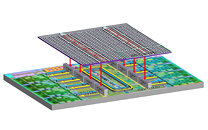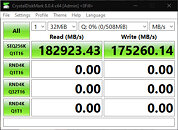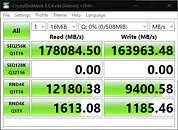- Joined
- Aug 19, 2017
- Messages
- 3,254 (1.13/day)
AMD's 3D V-Cache technology utilizes blocks of SRAM stacked on top of the CPU logic die, where CPU cores reside, and allows the processor to access massive pools of cache for applications. However, using this extra level 3 (L3) cache as a RAM disk appears possible, where the L3 SRAM behaves similarly to a storage drive. A big disclaimer here is that this is only possible by exposing the L3 to the CrystalDiskMark benchmark, and no real-world applications can do it in a way that CrystalDiskMark. According to X/Twitter user Nemez (@GPUsAreMagic), the steps to replicate this procedure are: Obtaining an AMD Ryzen CPU with 3D V-Cache, installing OSFMount and creating a FAT32 formatted RAM disk, and running CrystalDiskMark, with values set to values to SEQ 256 KB, Queue Depth 1, Threads 16, and data fill to 0s instead of random.
The results of this experiment? Well, they appear to be rather stunning as the nature of L3 SRAM is that the memory is tiny but very fast and accessible to the CPU, so it can help load data locally before going to the system RAM. With AMD Ryzen 7 5800X3D, the speeds of this RAM disk are over 182 GB/s for reading and over 175 GB/s for writing. In another test, shared by Albert Thomas (@ultrawide219), we managed to see RAM disk based on AMD Ryzen 7800X3D V-Cache, which scores a little less with over 178 GB/s read and over 163 GB/s write speeds. Again, CrystalDiskMark only performed these tests on small allocations varying between 16 MiB and 32 MiB, so no real-world workloads are yet able to utilize this.



View at TechPowerUp Main Site | Source
The results of this experiment? Well, they appear to be rather stunning as the nature of L3 SRAM is that the memory is tiny but very fast and accessible to the CPU, so it can help load data locally before going to the system RAM. With AMD Ryzen 7 5800X3D, the speeds of this RAM disk are over 182 GB/s for reading and over 175 GB/s for writing. In another test, shared by Albert Thomas (@ultrawide219), we managed to see RAM disk based on AMD Ryzen 7800X3D V-Cache, which scores a little less with over 178 GB/s read and over 163 GB/s write speeds. Again, CrystalDiskMark only performed these tests on small allocations varying between 16 MiB and 32 MiB, so no real-world workloads are yet able to utilize this.



View at TechPowerUp Main Site | Source







